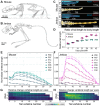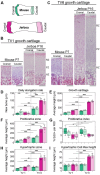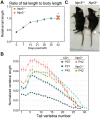This is a preprint.
Cellular and molecular mechanisms that shape the development and evolution of tail vertebral proportion in mice and jerboas
- PMID: 39484405
- PMCID: PMC11527341
- DOI: 10.1101/2024.10.25.620311
Cellular and molecular mechanisms that shape the development and evolution of tail vertebral proportion in mice and jerboas
Abstract
Despite the functional importance of the vertebral skeleton, little is known about how individual vertebrae elongate or achieve disproportionate lengths as in the giraffe neck. Rodent tails are an abundantly diverse and more tractable system to understand mechanisms of vertebral growth and proportion. In many rodents, disproportionately long mid-tail vertebrae form a 'crescendo-decrescendo' of lengths in the tail series. In bipedal jerboas, these vertebrae grow exceptionally long such that the adult tail is 1.5x the length of a mouse tail, relative to body length, with four fewer vertebrae. How do vertebrae with the same regional identity elongate differently from their neighbors to establish and diversify adult proportion? Here, we find that vertebral lengths are largely determined by differences in growth cartilage height and the number of cells progressing through endochondral ossification. Hypertrophic chondrocyte size, a major contributor to differential elongation in mammal limb bones, differs only in the longest jerboa mid-tail vertebrae where they are exceptionally large. To uncover candidate molecular mechanisms of disproportionate vertebral growth, we performed intersectional RNA-Seq of mouse and jerboa tail vertebrae with similar and disproportionate elongation rates. Many regulators of posterior axial identity and endochondral elongation are disproportionately differentially expressed in jerboa vertebrae. Among these, the inhibitory natriuretic peptide receptor C (NPR3) appears in multiple studies of rodent and human skeletal proportion suggesting it refines local growth rates broadly in the skeleton and broadly in mammals. Consistent with this hypothesis, NPR3 loss of function mice have abnormal tail and limb proportions. Therefore, in addition to genetic components of the complex process of vertebral evolution, these studies reveal fundamental mechanisms of skeletal growth and proportion.
Figures




Similar articles
-
Interspecies transcriptomics identify genes that underlie disproportionate foot growth in jerboas.Curr Biol. 2022 Jan 24;32(2):289-303.e6. doi: 10.1016/j.cub.2021.10.063. Epub 2021 Nov 17. Curr Biol. 2022. PMID: 34793695 Free PMC article.
-
Endochondral ossification and the evolution of limb proportions.Wiley Interdiscip Rev Dev Biol. 2020 Jul;9(4):e373. doi: 10.1002/wdev.373. Epub 2020 Jan 29. Wiley Interdiscip Rev Dev Biol. 2020. PMID: 31997553 Review.
-
Aegicetus gehennae, a new late Eocene protocetid (Cetacea, Archaeoceti) from Wadi Al Hitan, Egypt, and the transition to tail-powered swimming in whales.PLoS One. 2019 Dec 11;14(12):e0225391. doi: 10.1371/journal.pone.0225391. eCollection 2019. PLoS One. 2019. PMID: 31825956 Free PMC article.
-
The lesser Egyptian jerboa, Jaculus jaculus: a unique rodent model for evolution and development.Cold Spring Harb Protoc. 2011 Dec 1;2011(12):1451-6. doi: 10.1101/pdb.emo066704. Cold Spring Harb Protoc. 2011. PMID: 22135653
-
Developmental and Evolutionary Allometry of the Mammalian Limb Skeleton.Integr Comp Biol. 2019 Nov 1;59(5):1356-1368. doi: 10.1093/icb/icz082. Integr Comp Biol. 2019. PMID: 31180500 Free PMC article. Review.
References
-
- Cooper K.L., and Tabin C.J. (2009). Developmental patterning of the limb skeleton. In The Skeletal System (Cold Spring Harbor Press; ), p. 39.
Publication types
Grants and funding
LinkOut - more resources
Full Text Sources
